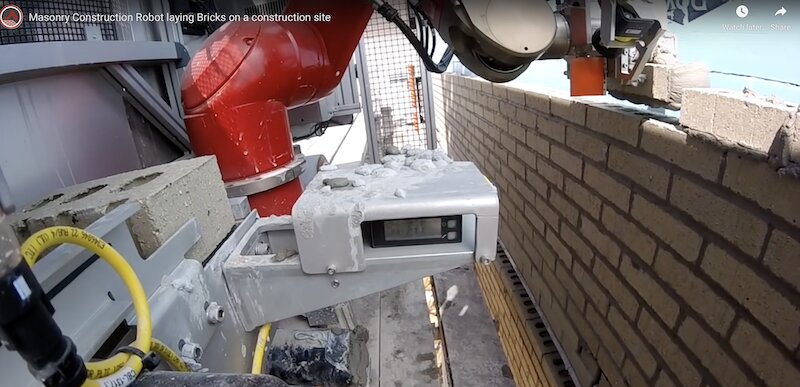A 166,000-sf barracks with 300 bedrooms for 600 military personnel is under construction at the Great Lakes Naval Base in Illinois with the help of robots that can lay bricks every seven to 10 seconds and can lift and place foundation blocks weighing up to 135 lbs.
This $52 million project, started last March and scheduled for completion in October 2020, represents the debut of semi-robotic construction for the general contractor Clark Construction Group. Construction Robotics, a Victor, N.Y.-based manufacturer that launched in 2007, is providing the machines, which are called MULE (for Material Unit Lift Enhancer) and SAM (for Semiautomated Mason). Blinderman Constuction is Clark's partner on this project.
This is also the first construction project in the country to use MULE and SAM technology in tandem.
There are currently more than 130 MULEs operating in the field, and 11 SAMs, with more under production, says Scott Peters, president and cofounder of Construction Robotics. His company has worked with more than 80 contractors, from large GCs like Barton Malow and Wilhelm Construction, to local masonry subcontractors like Leidal & Hart Mason Contractors in Michigan and Jimmy ‘Z Masonry in Crystal Lake, Ill., the latter of which is working on the abovementioned barracks project, and reportedly advocated for the use of robots.

The SAM robot can lay brick at a pace of one every 7-10 seconds.
Construction Robotics’ machines have installed more than one million sf of wall, says Peters, whose training is in engineering. His partner, Nate Podkaminer, has a background in architecture and construction.
Tyler Shawcross, Clark’s senior project manager, says that his company first met with Construction Robotics’ principals about five years ago. “Our R&D team is always looking for ways to build smarter,” he says.
When asked how this technology benefits masons at a time when workers are losing their jobs to automation in many industries, Shawcross notes that masonry, like many other construction trades, is suffering from labor shortages and an aging workforce. Plus, he adds, these trades simply are not attracting younger workers.
Construction Robotics has had a training program for masons in place since 2018. Both Peters and Shawcross agree that the technology not only has the potential for extending the work longevity of masons, but also might entice younger workers to consider entering the profession.
MULEs cost between $70,000 to $80,000 to purchase and are relatively simple to operate. For the barracks project, the MULE grabs the 32-inch blocks (which Oldcastle developed specifically for this job). The mason positions the hoisted block onto the foundation row. “It’s like an extension of your hand,” says Shawcross.
SAMs are more complicated machines that require three-to-five days of training to operate. The machines are generally leased by the week, month, or longer. Peters is reluctant to discuss pricing because, he explains, each project is different and requires customized software coding. (Peters notes that SAMs can be programmed to lay bricks in complex patterns and color sequences.)
To view videos of MULE and SAM in action, click here.
Construction Robotics claims SAMs reduce labor costs by at least 30%. Shawcross couldn’t quantify the time and cost savings from using the robots. He notes, though, that the machines provide a reliable production rate. “We see it as an opportunity to drive cost certainty into a project. I don’t think it’s a large cost reducer, but it could be a scheduling reducer.”
Peters says that robotics are most effective in construction when they are factored into the building process early in the planning stage. “That’s why we engage with GCs like Clark.” He concedes, however, that the construction industry in general is slow to change. “Companies need to think about new technology, and use their money to learn.”
Shawcross believes that robotics will become more prevalent on jobsites for performing repetitive tasks. Peters says that on another project, a MULE was used to move concrete form panels into place. “It’s one of those rare products that provides both speed and safety,” he says.
Related Stories
AEC Tech | Mar 9, 2024
9 steps for implementing digital transformation in your AEC business
Regardless of a businesses size and type, digital solutions like workflow automation software, AI-based analytics, and integrations can significantly enhance efficiency, productivity, and competitiveness.
AEC Tech | Feb 28, 2024
How to harness LIDAR and BIM technology for precise building data, equipment needs
By following the Scan to Point Cloud + Point Cloud to BIM process, organizations can leverage the power of LIDAR and BIM technology at the same time. This optimizes the documentation of existing building conditions, functions, and equipment needs as a current condition and as a starting point for future physical plant expansion projects.
AEC Innovators | Feb 28, 2024
How Suffolk Construction identifies ConTech and PropTech startups for investment, adoption
Contractor giant Suffolk Construction has invested in 27 ConTech and PropTech companies since 2019 through its Suffolk Technologies venture capital firm. Parker Mundt, Suffolk Technologies’ Vice President–Platforms, recently spoke with Building Design+Construction about his company’s investment strategy.
AEC Tech | Feb 20, 2024
AI for construction: What kind of tool can artificial intelligence become for AEC teams?
Avoiding the hype and gathering good data are half the battle toward making artificial intelligence tools useful for performing design, operational, and jobsite tasks.
AEC Tech | Feb 20, 2024
ABC releases technology guide for AI in construction
Associated Builders and Contractors has released an artificial intelligence (AI) technology guide for the U.S. construction industry. AI in Construction — What Does It Mean for Our Contractors? outlines definitions, construction use cases, and considerations for the implementation of AI in construction.
AEC Tech | Jan 24, 2024
4 ways AEC firms can benefit from digital transformation
While going digital might seem like a playground solely for industry giants, the truth is that any company can benefit from the power of technology.
Modular Building | Jan 19, 2024
Building with shipping containers not as eco-friendly as it seems
With millions of shipping containers lying empty at ports around the world, it may seem like repurposing them to construct buildings would be a clear environmental winner. The reality of building with shipping containers is complicated, though, and in many cases isn’t a net-positive for the environment, critics charge, according to a report by NPR's Chloe Veltman.
AEC Tech | Jan 8, 2024
What's driving the surge of digital transformation in AEC today?
For centuries, the AEC industry has clung to traditional methods and legacy processes—seated patterns that have bred resistance to change. This has made the adoption of new technologies a slow and hesitant process.
Sustainability | Nov 1, 2023
Researchers create building air leakage detection system using a camera in real time
Researchers at the U.S. Department of Energy’s Oak Ridge National Laboratory have developed a system that uses a camera to detect air leakage from buildings in real time.
Building Owners | Aug 23, 2023
Charles Pankow Foundation releases free project delivery selection tool for building owners, developers, and project teams
Building owners and project teams can use the new Building Owner Assessment Tool (BOAT) to better understand how an owner's decision-making profile impacts outcomes for different project delivery methods.
















